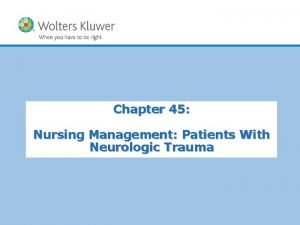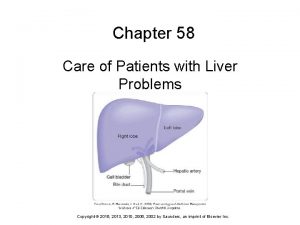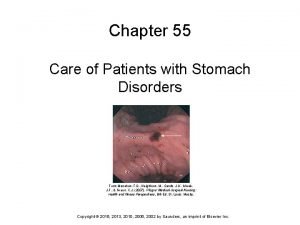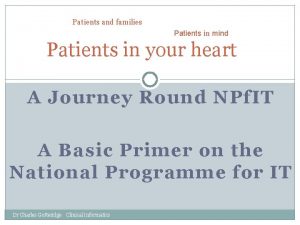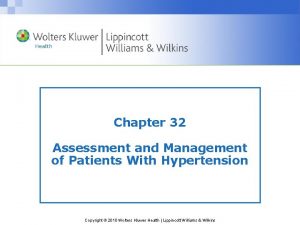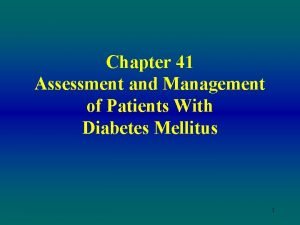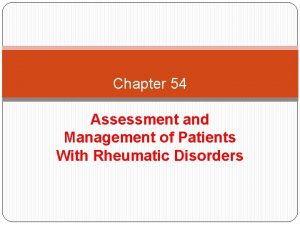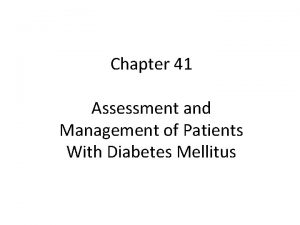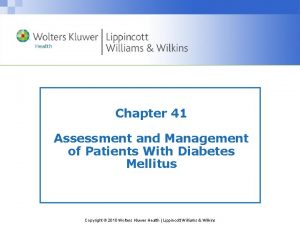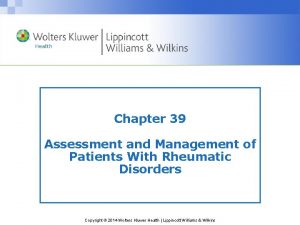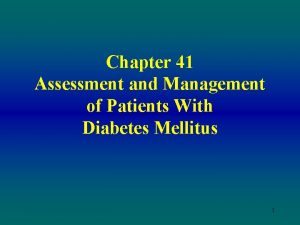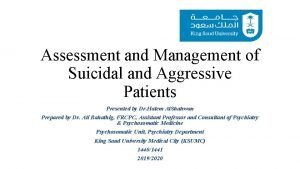Chapter 39 Assessment and Management of Patients With

















- Slides: 17

Chapter 39 Assessment and Management of Patients With Rheumatic Disorders Copyright © 2014 Wolters Kluwer Health | Lippincott Williams & Wilkins

Rheumatic Diseases • “Arthritis” • Affect primary the joints but also the muscles, bone, ligament, tendons, and cartilage • Remission and exacerbation • Classification – Monoarticular or polyarticular – Inflammatory or noninflammatory • Marked by inflammation, autoimmunity, and degeneration Copyright © 2014 Wolters Kluwer Health | Lippincott Williams & Wilkins

Question Is the following statement true or false? Diarthrodial is bleeding into a joint. Copyright © 2014 Wolters Kluwer Health | Lippincott Williams & Wilkins

Answer False Diarthrodial is a joint with two freely movable parts. Hemarthrosis is bleeding into a joint. Copyright © 2014 Wolters Kluwer Health | Lippincott Williams & Wilkins

Characteristic Degenerative Changes— “Degradation” Copyright © 2014 Wolters Kluwer Health | Lippincott Williams & Wilkins

Clinical Manifestations • Pain • Joint swelling • Limited movement • Stiffness • Weakness • Fatigue Copyright © 2014 Wolters Kluwer Health | Lippincott Williams & Wilkins

Pathophysiology and Associated Physical Signs of Rheumatoid Arthritis Copyright © 2014 Wolters Kluwer Health | Lippincott Williams & Wilkins

Nursing Process: The Care of the Patient With a Rheumatic Disease—Assessment • Health history: include onset of and evolution of symptoms, family history, past health history, and contributing factors • Functional assessment • Arthrocentesis • Radiography, bone scans, CT, and MRI • Tissue biopsy • Blood studies Copyright © 2014 Wolters Kluwer Health | Lippincott Williams & Wilkins

Nursing Process: The Care of the Patient With a Rheumatic Disease—Diagnoses • Acute and chronic pain • Fatigue • Disturbed sleep pattern • Impaired physical mobility • Self-care deficits • Disturbed body image • Ineffective coping Copyright © 2014 Wolters Kluwer Health | Lippincott Williams & Wilkins

Collaborative Problems and Potential Complications • Adverse effects of medications Copyright © 2014 Wolters Kluwer Health | Lippincott Williams & Wilkins

Nursing Process: The Care of the Patient With a Rheumatic Disease—Planning • Major goals may include – Relief of pain and discomfort – Relief of fatigue – Promotion of restorative sleep – Increased mobility – Maintenance of self-care – Improved body image – Effective coping – Absence of complications Copyright © 2014 Wolters Kluwer Health | Lippincott Williams & Wilkins

Nursing Process: The Care of the Patient With a Rheumatic Disease—Interventions • Anti-inflammatory medications • Heat to joints for pain management • Splints, but maintain mobility • Provide rest Copyright © 2014 Wolters Kluwer Health | Lippincott Williams & Wilkins

Diffuse Connective Tissue Diseases • A group of chronic disorders characterized by diffuse inflammation and degeneration in the connective tissue • Cause is unknown but thought to have an immunologic basis • Characterized by a clinical course of exacerbations and remissions • Includes RA, SLE, scleroderma, polymyositis, and polymyalgia rheumatica Copyright © 2014 Wolters Kluwer Health | Lippincott Williams & Wilkins

Systemic Effects: Extraarticular Features • Fever • Fatigue • Anemia • Lymph node enlargement • Raynaud’s phenomenon and Sjögren’s syndrome • Any organ system may be involved; arteritis, neuropathy and other neurologic manifestations, scleritis, pericarditis, pleural effusion, splenomegaly, renal involvement • Skin and mucosal manifestations Copyright © 2014 Wolters Kluwer Health | Lippincott Williams & Wilkins

Teaching Patients Self-Care • Explain the disease and principles of disease management • Medication teaching • Monitoring • Sources of information • Pain management • Joint protection • Self-care with assistive devices • Exercise and relaxation Copyright © 2014 Wolters Kluwer Health | Lippincott Williams & Wilkins

Question With which of these diagnoses should the nurse encourage the patient to restrict consumption of foods high in purine? A. Fibromyalgia B. Gout C. Osteoarthritis D. Rheumatoid arthritis Copyright © 2014 Wolters Kluwer Health | Lippincott Williams & Wilkins

Answer B. Gout The nurse encourage the patient to restrict consumption of foods high in purine for gout. Copyright © 2014 Wolters Kluwer Health | Lippincott Williams & Wilkins
 Rapid extrication technique emt
Rapid extrication technique emt Types of lifting and moving patients
Types of lifting and moving patients Backboard strapping techniques
Backboard strapping techniques Lippincott williams & wilkins
Lippincott williams & wilkins Management of patients with neurologic trauma
Management of patients with neurologic trauma Cva
Cva Chapter 36 patients with special challenges
Chapter 36 patients with special challenges Chapter 58 care of patients with liver problems
Chapter 58 care of patients with liver problems Chapter 55 care of patients with stomach disorders
Chapter 55 care of patients with stomach disorders Chapter 21 assessment and management auditory problems
Chapter 21 assessment and management auditory problems Ionic compounds
Ionic compounds Chapter 7 chapter assessment ionic compounds and metals
Chapter 7 chapter assessment ionic compounds and metals Moving and handling dementia patients
Moving and handling dementia patients Semi fowlers position
Semi fowlers position 10 rights of the patient
10 rights of the patient Safe staffing ratios benefiting nurses and patients
Safe staffing ratios benefiting nurses and patients Medicare improvements for patients and providers act
Medicare improvements for patients and providers act Urgent move emt
Urgent move emt




